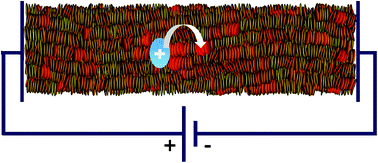Temperature dependence of charge mobility in model discotic liquid crystals†
Abstract
We address the calculation of charge carrier mobility of liquid-crystalline columnar semiconductors, a very promising class of materials in the field of organic electronics. We employ a simple coarse-grained theoretical approach and study in particular the temperature dependence of the mobility of the well-known triphenylene family of compounds, combining a molecular-level simulation for reproducing the structural changes and the Miller–Abrahams model for the evaluation of the transfer rates within the hopping regime. The effects of electric field, positional and energetic disorder are also considered. Simulations predict a low energetic disorder (∼0.05 eV), slightly decreasing with temperature within the crystal, columnar and isotropic phases, and fluctuations of the square transfer integral of the order of 0.003 eV2. The shape of the temperature-dependent mobility curve is however dominated by the variation of the transfer integral and barely affected by the disorder. Overall, this model reproduces semi-quantitatively all the features of experimentally measured mobilities, on one hand reinforcing the correctness of the hopping transport picture and of its interplay with system morphology, and on the other suggesting future applications for off-lattice modeling of organic electronics devices.


 Please wait while we load your content...
Please wait while we load your content...